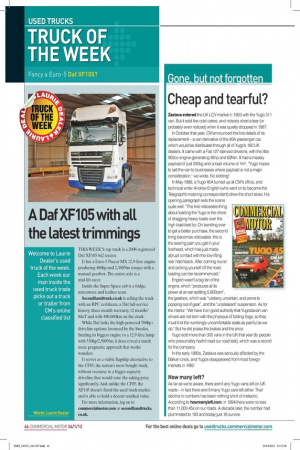Cheap and tearful?
Page 38

If you've noticed an error in this article please click here to report it so we can fix it.
Zastava entered the UK LCV market in 1983 with the Yugo 311 van. But it sold like cold cakes, and nobody shed a tear (or probably even noticed) when it was quietly dropped in 1987.
In October that year, CM announced the first details of its replacement — a van derivative of the 45A passenger car, which would be distributed through all of Yugo's 180 UK dealers. It came with a Fiat 127-derived driveline, with the little 903cc engine generating 45hp and 62Nm. It had a measly payload of just 250kg and a load volume of 1m3. "Yugo hopes to sell the van to businesses where payload is not a major consideration," we wrote. No kidding!
In May 1988, a Yugo 45A turned up at CM's office, and technical writer Andrew English (who went on to become the Telegraph's motoring correspondent) drew the short straw. His opening paragraph sets the scene quite well: "The first noticeable thing about loading the Yugo is the chore of dragging heavy loads over the high load-bed lip. On bending over to get a better purchase, the second thing becomes noticeable: this is the searing pain you get in your forehead, which has just made abrupt contact with the low-lifting rear hatchback. After coming round and picking yourself off the road, loading can be recommenced."
English wasn't a big fan of the engine, which "produces all its power at an ear-splitting 5,800rpm", the gearbox, which was "rubbery, uncertain, and prone to popping out of gear", and the "unpleasant" suspension. As for the interior: "We have it on good authority that Yugoslavian van drivers are not born with the physique of folding frogs, so they must find the numbingly uncomfortable seats as painful as we do." But he did praise the brakes and the price.
Yugo sold more than 300 vans in the UK that year (to people who presumably hadn't read our road test), which was a record for the company.
In the early 1990s, Zastava was seriously affected by the Balkan crisis, and Yugos disappeared from most foreign markets in 1992.
How many left?
As far as we're aware, there aren't any Yugo vans left on UK roads — in fact there aren't many Yugo cars left either. Their decline in numbers has been nothing short of meteoric. According to howmanyleft.com, in 1994 there were no less than 11,000 45s on our roads. A decade later, the number had plummeted to 193 and today just 16 survive.










































